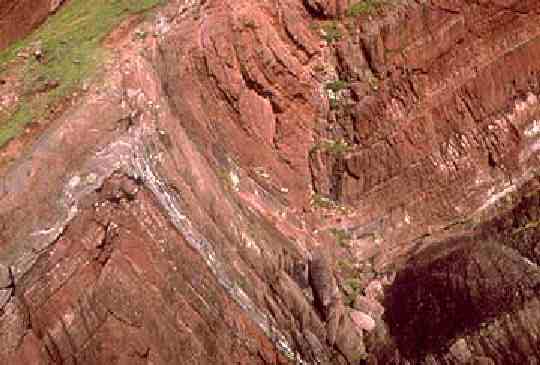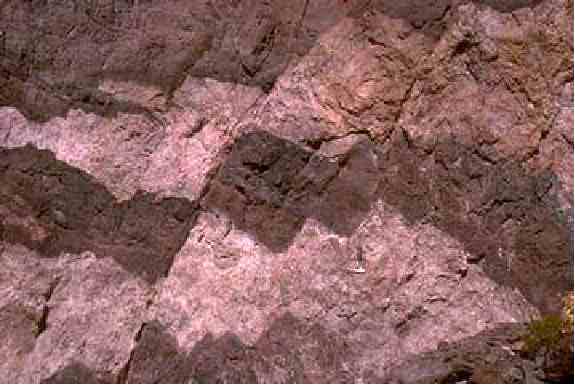
Kinematic analysis is the
reconstruction of movements that take place during the formation and deformation
of rocks, at all scales. Kinematic analysis deals with recognizing
and describing the changes that, during deformation, are brought about
by movement of the body as a whole, or by internal movements within
the body. Kinematic analysis is carried out at all scales, from submicroscopic
to regional. When a body, or some part of a body, is forced to change
its location or position, it undergoes translation. When forced to change
its orientation, it undergoes rotation. When forced to change size,
it undergoes dilation. When forced to change shape, it undergoes distortion.
The overall goal of Kinematic Analysis is to interpret the combinations
of translations, rotations, distortions, and dilations that altered the
location, orientation, shape and size of a body of rock. Folds are a very
good example of the application of kinematic analysis to geologic structures.

![]()
Dynamic analysis interprets forces, stresses, and the
mechanics that give rise to structures. For dynamic analysis to be meaningful,
it must explain the physical and geometric character of the structures,
the kinematics, and the relationship between stress and strain. The major
aim of the analysis is to describe the orientation and magnitude of the
stress, and the response of the material. this is a challenging step in
detailed structural analysis, because significant inferences must be made
regarding the environment of deformation (i.e., temperature, pressure...)
, the strength and physical state os the materials during deformation,
the rate at which deformation proceeded and the boundary conditions (e.g.,
relationship to plate movements and plate boundaries). Overall, dynamic
analysis is all about the interplay between the stresses that tend to deform,
and the strengths that tend to resist. Faults are a great example
in which we can see the dynamic analysis' application.

![]()
Deformation Mechanisms and Microstructures
Processes that permit rocks to deform
at the microscopic and atomic scale are called deformation mechanisms.
The fine scale structures that are produced are called microstructures.
Nature has a long list of deformation mechanisms to choose from, and this
accounts for the wide variety of observed microstructures and textures.
Some deformation mechanisms are brittle, like the splitting of minerals
along microscopic cracks or cleavages; others are ductile, like the slippage
on hundreds of parallel crystallographic planes of the forced march migration
of atoms from one side of a mineral to another. We can go from microstructures
to the deformation mechanisms that produced them by creating microstructures
under controlled laboratory conditions, describing the microstructures
on the basis of high magnification microscopy, comparing the microstructures
produced in the laboratory to those produced in nature, an applying concepts
and interpretations consistent with theoretical analysis of the strength
of minerals.

![]()